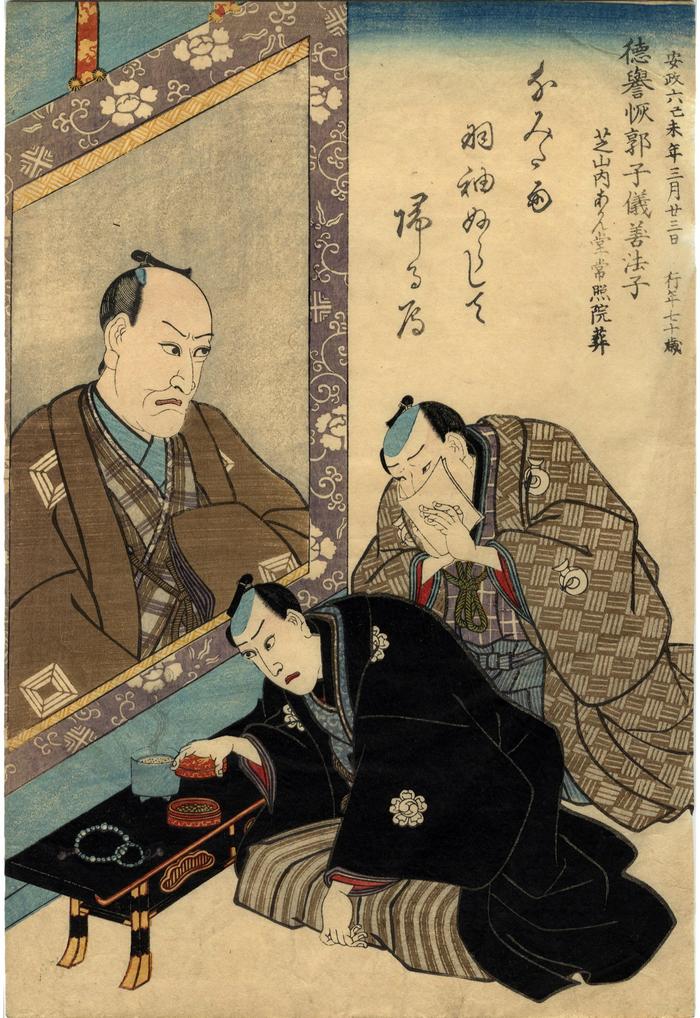Utagawa Kunisada (歌川国貞) / Toyokuni III (三代豊国) (artist 1786 – 01/12/1865)
Shini-e of two actors, Ichikawa Hakuen IV and Kawarazaki Gonjūrō I, grieving the loss of a Ichikawa Ebizō V
03/23/1859
9.25 in x 13.75 in (Overall dimensions) Japanese color woodblock print
Waseda University
Tokyo Metropolitan Library
Victoria and Albert Museum
Hankyu Culture Foundation
National Museum of Japanese History (via Ritsumeikan University) One of the mourners has been identified as Ichikawa Hakuen IV (Ichikawa Komazō VII/Ichikawa Ebizō VII) who died in 1874. The other mourner may be Kawarazaki Gonjūrō I (Ichikawa Danjūrō IX) who died in 1903. [The identity of the mourners was provided by the Hankyu Cultural Foundation.]
The figure in the hanging scroll is wearing a robe decorated with the Ichikawa mon, the mimasu or 'three enclosed measures of rice'. In the copy of this print in the Victoria and Albert Museum there is a Toyokuni hitsu signature on the scroll. This is the only example we have found so far with a signature. All of the other linked examples are like the print shown here from the Lyon Collection.
Beverly Angelique Taylor in her 1995 doctoral thesis on page 157 sited information from Samuel L. Leiter that said that "The three boxes of the Ichikawa crest represent three measure (masu) of rice given by a devoted fan to Ichikawa Danjūrō I..."
The first part of the text reads:
安政六己未年三月廿三日 徳誉恢郭子儀善法子 芝山内あかん堂常照院葬
The rest reads:
なみた雨羽袖ぬらして帰る鳥
****
Since most shini-e are anonymous, this print had only been ascribed to Toyokuni III on stylistic grounds. However, we discovered that there is another edition of this print using the same blocks, but that one has Toyokuni's signature next to the portrait in the hanging scroll. That one can be found in the collection of the Victoria and Albert Museum. Other than that, most copies of this print that we have found in Japanese institutional collections list it as by an unknown artist.
****
Julien Faury wrote about different paradigms of shini-e in an article in Arts asiatiques in 2011: "Si le schéma classique du shini-e offre généralement une image figée du défunt représenté dans le costume de son rôle phare (atari-yaku 当たり役) ou, comme nous venons de le voir, en hakama bleu en guise de linceul, certains ont également cherché à faire le lien entre ce monde et l’au-delà, soit en montrant ceux qui pleurent le défunt se lamenter devant le portrait de ce dernier, soit en mettant en scène l’accueil fait par ses prédécesseurs au nouveau venu."
The Google translation reads: "While the classic shini-e pattern generally offers a frozen image of the deceased depicted in the costume of his leading role (atari-yaku 当たり役) or, as we have just seen, in a blue hakama as a shroud, some have also sought to make a link between this world and the afterlife, either by showing those mourning the deceased lamenting in front of the latter's portrait, or by depicting the welcome given to the newcomer by his predecessors."
Faury notes that this motif of mourners before the hanging scroll basically shows a shini-e within a shini-e.
If you click on the image and enlarge it you will notice that the figure in the black robe has lifted the lid on a container that appears to contain incense pellets that he could drop into the incense burner right next to it. Looking more closely and you will see that there is smoke rising from this burner and perhaps it is meant to be hangon-ko (反魂香) or the 'incense which supposedly allows the spirit of a departed loved one to be seen in the smoke' even though it is right in front of his painted likeness. A Buddhist rosary lies nearby.
shini-e (死絵) (genre)
actor prints (yakusha-e - 役者絵) (genre)
Ichikawa Ebizō V (五代目市川海老蔵: 11/1797 to 10/1800 and 3/1832 to 3/1859) (actor)
Ichikawa Danjūrō IX (九代目市川團十郞: July 1874 to 1903) (actor)
Ichikawa Komazō VII (七代目市川高麗蔵: from 3/1844 to 2/1856) (actor)
